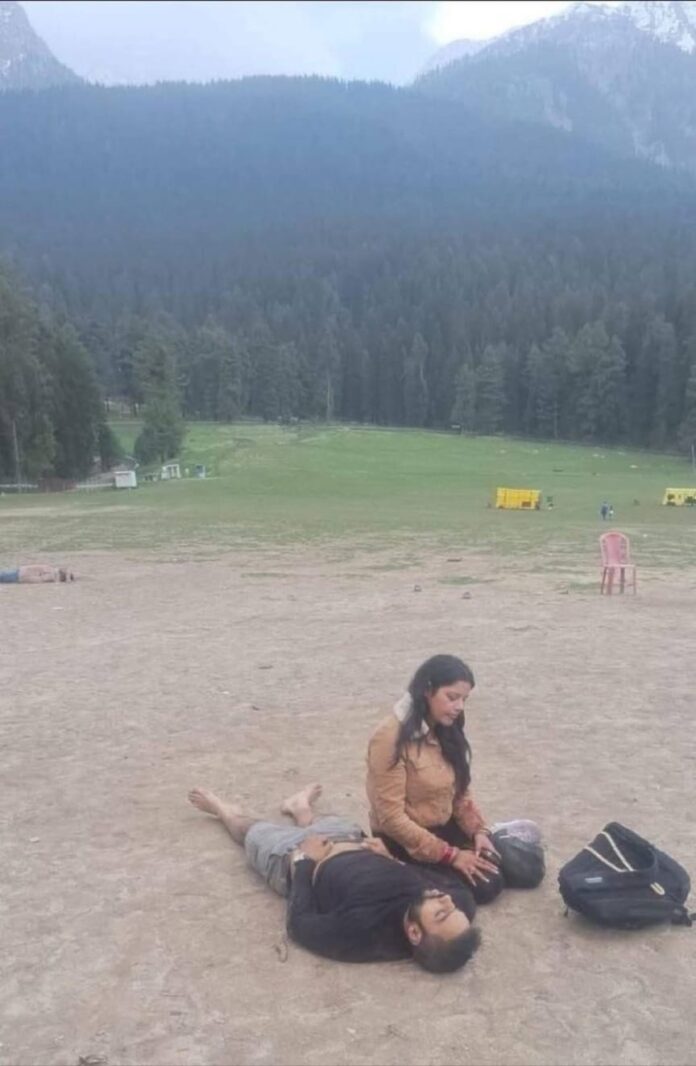-Anshita Mishra
The country bleeds today as old fears creep back into Jammu and Kashmir. The terrorist attack in Pahalgam, Jammu and Kashmir, has claimed 27 lives, including that of an Israeli national and an Italian national, and has injured scores of others. It is being branded as the most lethal and large-scale attack – enough to be synonymous with a massacre – on the civilian faction so far in the last three decades. This attack is yet another in the string of attacks targeted at both civilians and military personnel ever since the election of Omar Abdullah as Chief Minister of the Union Territory. That the killed are all tourists brings to light the fact of the growing integration between Kashmir and the rest of India, which has been significantly beneficial to the UT over the last five years, including the organisation of the G20 summit in Srinagar.
Tourism significantly contributes to the economy of Jammu and Kashmir, accounting for a substantial portion of the State Gross Domestic Product (GSDP). If we look at statistics, these are the particulars:
Economic Impact:
- GDP Contribution:Tourism contributes around 7% to the GSDP of Jammu and Kashmir.
- Employment:The industry provides employment to approximately 70,000 people directly and indirectly.
- Revenue:The tourism industry generates around Rs. 8,000 crores annually.
- Infrastructure Development:Tourism drives the development of infrastructure like roads, hotels, and other facilities, further stimulating economic activity.
- Local Industries:The sector supports the growth of local industries like handicrafts and handlooms, providing economic opportunities for local artisans.
Tourist Inflow:
- Jammu and Kashmir has seen an increase in tourist visits, with a record 2.11 crore tourists in 2023.
- Foreign tourist arrivals have also increased significantly, with a 2.5-fold increase.
- Religious tourism, particularly to shrines like Vaishno Devi and Amarnath, is a major driver of tourism in the region.
A total of 1,08,41,009 tourists visited Jammu and Kashmir between January and June 2024 and 2,11,24,674 in 2023 – all-time high so far – followed by the visit of 1,88,64,332 tourists in 2022, 1,13,14,884 in 2021 and 34,70,834 tourists in 2020.
The timing of this carnage is no coincidence – US Vice President JD Vance is on a high-profile visit to India, while the PM is visiting Saudi Arabia. This attack, like all attacks in the past, is to send out a clear message to India and to the rest of the world. The message being – Jammu & Kashmir is an unstable, volatile, and unsafe region. It is to establish a sense of fear in the minds of the tourists – who are major contributors to the economy of the UT – to prevent them from travelling to J&K, only to further alienate the Valley from the rest of the country. History is witness to the fact that local terrorists, militants, and incidents of stone pelting have flourished under the haven of NC and PDP before the rightful abrogation of Articles 370 and 35(A) in 2019. Not only is this attack an attempt to ostracise the Valley from the rest of the country – literally and metaphorically – but also an attempt to amputate the economic landscape of J&K.
Bigger questions arise on the preparedness and prowess of the intelligence agencies, and their inability to track this on their radar. It’s high time we started anticipating the timing accurately of such attacks to avert such security fiascos and debacles in the future. The fact that Pahalgam was chosen as the target location of this attack signals that it was a deliberate decision, given that it is one of the most popular tourist spots in the region. The terrorists and their handlers singled out Pahalgam via this calculated act of violence to hurt the tourists as well as the locals, boosting the exodus of the tourists, cutting the tourist influx vis-a-vis the upcoming Amarnath Yatra, consequently draining out the revenue streams for the locals.
Another key observation to be made here is that this is a classic case of hardcore identity-based killings targeting only Hindus. And here’s a rather important lesson for India and Indians – among those killed in Pahalgam today was someone from Karnataka, someone from North-East India, someone from Maharashtra, someone from Gujarat, and someone from up North, among other parts of the country. They weren’t asked what Indian state they belonged to, or what language they spoke. Just their religious identity was enough to paint the bull’s eye on their backs.
Indians cannot operate in silos on the pretext of divisive regional and linguistic politics that is often played out in the Indian landscape. What we need today is a cohesive social fabric that cannot be torn apart by external – or internal – forces. We have more pressing matters to focus on and resolve than fight each other on such trivial things as regional and linguistic differences, other politics of the like, or dwell upon what comedian cracked what jokes, etc. India is under attack, and she needs her citizens to act in a more reasonable and responsible fashion.
To be seen as a silver lining in this dark hour, there’s news coming in that there are calls for a Kashmir Bandh by the locals in solidarity with the tourists and against terrorism in the Valley. Once called for against the security forces until six years ago, now a Kashmir Bandh is being called in to rally in their support. This is symbolic of a mindset shift in the local Kashmiris after having experienced integration with the rest of the country and a boost in their earnings post 2019. This signifies how the locals have foiled Pakistan’s attempt to pit them against the rest of India through this attack.
While the PM is set to return to India tonight itself, cutting his visit to Saudi Arabia short, it still needs to be debated what actions will be taken in the aftermath of this attack to retaliate, and whether it will be enough. While brainstorming strategic alternatives to narrow down on the most appropriate response to this massacre, we need to ask one question – will we be comfortable climbing up the escalation ladder instead of crumbling under international pressure, if need be? If our trajectory so far is to be believed, the pattern is as follows: Pakistan Army backed terror outfit attacks us, we hit back, case closed. It’s almost like Pakistan slaps us, we slap them back, even the scores out, and that’s about it. To ensure a much greater impact and a permanent solution, we need to abandon the fear of “what ifs”, and accelerate gears instead of de-escalating. This is exactly what emboldens the belief of the average citizen and defence personnel in the national security system and the government that they have elected to power.
(Views are personal)












